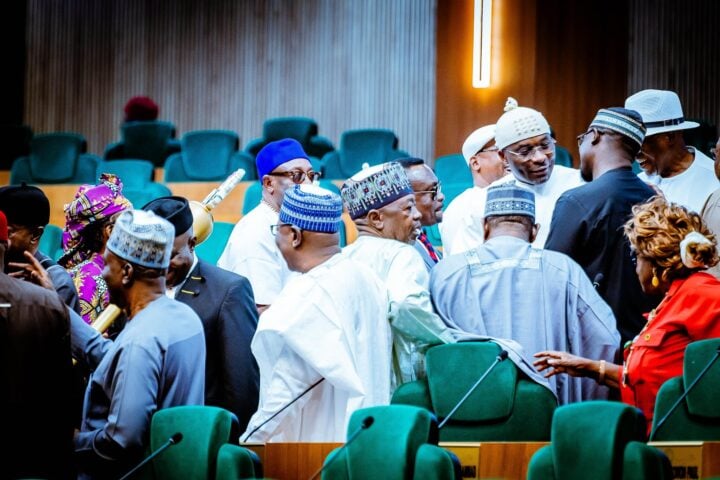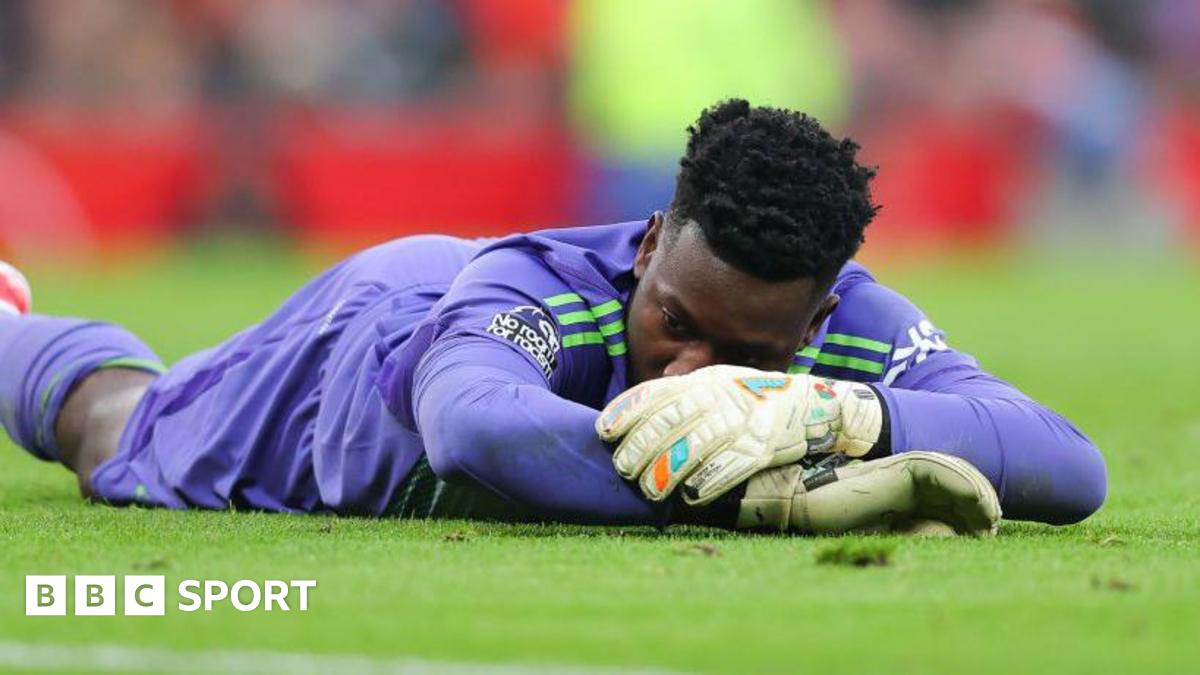The VAR Review: Should Aston Villa's 'goal' have been awarded? - ESPN
Video Assistant Referee causes controversy every week in the Premier League, but how are decisions made, and are they correct?
After each weekend we take a look at the major incidents, to examine and explain the process both in terms of VAR protocol and the Laws of the Game.
Would Morgan Rogers' goal at Manchester United have counted had the referee not blown the whistle? Were the red cards for Aston Villa goalkeeper Emiliano Martínez and Liverpool midfielder Ryan Gravenberch correct? And did the VAR miss any handball spot kicks on the final matchday?
Aston Villa were on the attack in the 72nd minute when Manchester United centre-back Harry Maguire nodded the ball back to his goalkeeper, Altay Bayindir. The 27-year-old hesitated slightly, allowing the ball to spin in his gloves, and Morgan Rogers nipped in to steal it. But before he could put the ball into the empty net, referee Thomas Bramall blew for a foul.
No intervention possible.
The VAR was locked out of the decision, because as soon as Bramall blew his whistle the play was dead -- anything that happened after that point, including a possible goal, is void. The referee should have waited, but he was too quick to penalise the foul.
The wording on the law about a goalkeeper being in control of the ball is clunky. It defines it as: "The ball is between the hands or between the hand and any surface (e.g. ground, own body) or by touching it with any part of the hands or arms, except if the ball rebounds from the goalkeeper or the goalkeeper has made a save."
Taking that on face value, it would suggest that simply "touching it with any part of the hands or arms" defines control. In this case, the VAR's key consideration would be Bayindir having both hands on the ball, or it being on the ground with the keeper having a hand on it. The ball just being in contact with Bayindir's glove wouldn't be enough to qualify as control.
The VAR would be looking for three things: does the 'keeper have his glove on the ball when it is touching the ground? Does Rogers kick the ball when it is in both Bayindir's hands? Does Rogers kick the opponent's hand? The answer to all three is no. So on VAR review, the goal would have been given.
After Rogers kicked the ball, it then ended up in both Bayindir's gloves, but he failed to hold it. The next touch from Rogers when was the ball was again loose.
Villa have past experience of this law. In December 2021, they had a goal disallowed against Leicester City when goalkeeper Kasper Schmeichel had his fingertips on top of the ball as it was kicked into the net by Jacob Ramsey, with the VAR intervening to rule out the goal.
It caused a great deal of controversy, because it was felt that a 'keeper cannot be in control if they are only just touching it -- but law says they are when the ball is grounded.
Villa were understandably furious with Rogers' goal being ruled out -- with the score at 0-0 and 18 minutes to be played, results in other fixtures meant a point would have been enough to get them into the UEFA Champions League. Villa's main complaint was over the experience of the referee for such a big game, with Bramall taking charge of his 11th top-flight game of the season and the 30th of his career (his first at Old Trafford). Yet Tony Harrington, in the middle for Newcastle United vs. Everton, was refereeing only his 37th Premier League game.
Bramall has moved between the Championship and the Premier League throughout the season, though has increasingly been given higher-profile games -- he refereed Liverpool's title-winning game against Tottenham Hotspur last month.
The appointments are always stretched on the final day, with 30 to be made across referee, VAR and fourth official, and only 20 Select Group 1 referees. Bramall has done big playoff matches before, but having Peter Bankes or John Brooks, who were both on VAR duty, as referee may have made more sense. Michael Oliver only acted as VAR for Spurs vs. Brighton & Hove Albion, though as a Newcastle supporter he was unlikely to be given a final-day game involving one of the Magpies' rivals for the Champions League.
VAR protocol is clear that the referee should hold the whistle for any immediate scoring chance, and that applies to a foul and not just offside. Bramall obviously felt he was certain the goalkeeper was in control of the ball when Rogers kicked it, and that's fine -- in real time it's easy to come to that conclusion. But with the ball inside the penalty area he should have waited a couple of seconds to see what happened before stopping play. Maybe he (mistakenly) thought that with play over to the left of the area there was no scoring chance.
Maybe it's a little more difficult for referees earlier into their career with VAR. It's the second time this season a goal has been wrongly disallowed due to an early whistle. In August, Sam Barrott stopped play after a free kick was taken by Eberechi Eze, penalising Crystal Palace's Will Hughes for a foul on Brentford's Nathan Collins -- but Eze had caught out Bees goalkeeper Mark Flekken with a shot from distance. The whistle went before the ball went in, but the VAR couldn't get involved to tell the referee there was no foul by Hughes. Barrott, who has since been promoted to the FIFA and UEFA international lists, was refereeing only his 20th game with VAR.
Rasmus Højlund ran onto a poor backpass from Matty Cash in first-half stoppage time. Villa 'keeper Emiliano Martínez came out of his area and brought down Højlund after the striker had nudged the ball past him. Referee Bramall produced the red card for denying an obvious goal-scoring opportunity (DOGSO), which was supported by the VAR.
Red card stands.
Last weekend, Crystal Palace goalkeeper Dean Henderson escaped a DOGSO red card in the FA Cup after handling the ball outside the area as Manchester City's Erling Haaland ran through on goal.
The referee at Wembley was Stuart Attwell, and he was on VAR for this decision. Yet we shouldn't expect both to result in the same outcome -- especially if the general consensus was that not sending off Henderson was incorrect.
DOGSO is always about weighing up a variety of criteria, and not concentrating too much on one specific aspect. That said, we've heard many times this season how the general direction of the play being away from goal is very important, and that has often been the reason why the VAR hasn't got involved to upgrade yellow to red. Højlund's touch taking the ball into a wider area may have led to the VAR supporting a yellow card, if the referee had chosen that sanction.
Henderson's was a clearer red card as his handball prevented Haaland from taking a touch toward goal, only the handball offence forced the ball wide. With Højlund, we knew the outcome of the striker's play of the ball, which was into the channel.
As Højlund is past the goalkeeper with the ball in front of him, the VAR isn't going to tell the referee a DOGSO red card is a mistake here. After all, it's similar to what Rogers did, admittedly from closer to goal. But we've seen similar situations where a yellow by the referee has been supported on video review. As ever, the original decision of the referee carries the weight, and that's what creates the perception of inconsistency because VAR's role isn't to make decisions based upon precedent.
Man United were awarded a penalty in the 85th minute when Amad went down in the box under a challenge from Ian Maatsen, and it was checked by the VAR.
Penalty stands, scored by Christian Eriksen.
Maatsen may not have been attempting to challenge the Manchester United attacker, but he stood on his boot and that caused him to go to ground.
Just like when a defender clips a striker's heels from behind, intent to cause a foul isn't important: Amad went to ground because of the contact from Maatsen.
With clear evidence of contact from defender on attacker, there's no likelihood the VAR is going to get involved to overturn such a penalty.
Mohamed Salah cut inside for a shot in the 50th minute, which was deflected behind for a corner off Maxence Lacroix. Salah was adamant that Liverpool should have been awarded for a penalty for handball, and it was looked at by the VAR, Paul Howard.
No penalty.
A close call for Lacroix, as there appeared to be some movement of the elbow to get in the way of Salah's shot.
However, the ball came off the Crystal Palace player's lower arm, around the wrist area, which was very close to his side.
Had the ball hit the defender's elbow this should have been a penalty for deliberate handball -- though it wouldn't have been a red card for denying a goal as the goalkeeper was directly behind Lacroix.
Ryan Gravenberch was sent off for DOGSO in the 68th minute after bringing down Daichi Kamada. Was there a question of the quality of the scoring chance? It was checked by the VAR.
Red card stands.
We've seen a few DOGSO red cards this season where the attacker has been brought down close to the halfway line -- William Saliba, Myles Lewis-Skelly and Mateo Kovacic being the notable ones.
The question was whether the touch by Kamada was too heavy, meaning there was a likelihood that goalkeeper Alisson Becker would have been able to intercept the ball first?
Alisson was out of his area (though starting to move back) and the ball was bouncing through with a degree of speed -- and that did create some doubt for a red card.
Compare that to Saliba's red card vs. Bournemouth, given through VAR, where the ball was coming to a stop halfway to goal and goalkeeper David Raya was backtracking fully into his area. Because of this, Kamada had less of a scoring chance than Evanilson, when he was brought down by Saliba.
Had the referee produced a yellow card, the VAR may well have supported that due to the possibility that Alisson would have intercepted before Kamada could shoot. That doubt wasn't present on the Saliba red card, which is why there was a VAR intervention to upgrade to red.
It's borderline for the VAR to step in on the Gravenberch sending off, and the Liverpool midfielder is probably a little unfortunate. It's somewhat moot, however, as Gravenberch was already on a caution so would still have been sent off had the referee produced a yellow card. Either sanction would have seen the midfielder dismissed and the given a one-match suspension.
However, as it was a straight red card Liverpool would have the option to appeal. The quirk is that the suspension would be removed, rather than the red downgraded to a yellow and the ban staying in place -- though an appeal it's highly unlikely to be successful
Southampton 1-2 Arsenal
Possible penalty: Handball by Rice
Yukinari Sugawara hit a shot from distance in the 20th minute, with the ball coming off Declan Rice and going behind for a corner. It was checked for a spot kick by the VAR, Graham Scott.()
No penalty.
Premier League referees have been consistent throughout the season in only penalising handball when the arm has been fully extended away from the body, high, or there's a deliberate act. But does that fit with the potential Rice handball?
One of the considerations for the VAR is the position of the arm when the shot is taken, and where it is when it's hit by the ball. So, if the arm hasn't moved, and is an expected position for the player's movement, then it shouldn't be a penalty. And this is where there was a question for Rice.
After Sugawara hit the shot, Rice had his left arm behind his back.
Rice did have his arm close to his body, but it then came up into a raised position and blocked the shot.
There were only nine handball penalties in the Premier League this season, far fewer than the rest of the top leagues. The Key Match Incidents Panel hasn't ruled that a VAR has missed one either, though it did feel the referee should have given Nottingham Forest a spot kick against Wolverhampton Wanderers in January.
Handball is in a better place in England than it is on the continent, though there's an argument that, in cases such as this, the interpretation is a little too liberal and it should be a spot kick.
Newcastle 0-1 Everton
Possible penalty: Handball by Livramento
The game was in the 47th minute when Jack Harrison burst into the area and fired a ball across the area. It hit the arm of Valentino Livramento, with Everton's players appealing for a penalty. Referee Tony Harrington wasn't interested so it was over to the VAR, Paul Tierney.
VAR decision: No penalty.
VAR review: The ball definitely touches the hand of the Newcastle defender, but there are a few reasons why the VAR wouldn't advise a spot kick.
First, the ball is flicked on by Fabian Schär, which slight alters the trajectory. Livramento is also trying to retract his arm away from the path of the ball, and it hits him in an expected position close for his movement, close to the body.
Verdict: While we can question the possible penalty against Rice, there was no prospect of this being a penalty on review.
Some factual parts of this article include information provided by the Premier League and PGMOL.












